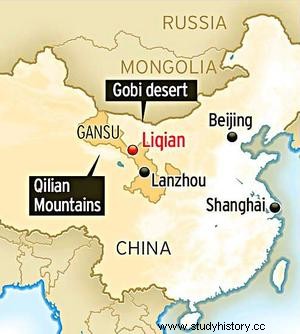Logically, Rome not only lost these two legions, but both that of Crassus in Carrhae and the IX Hispana in Britannia have been the most striking due to the mystery surrounding their disappearance. This is his story…
Crassus' legion
In the late spring of 53 BC, a huge Roman army commanded by Marcus Licinius Crassus , the richest and most arrogant man in Rome, triumvir along with Caesar and Pompey and governor of Syria in that year, entered Parthian territory ready to achieve in the confines of Asia the honor and glory that he could not buy with his immense fortune . It was June 9 when he met the Parthian general Surena at the head of a contingent of light cavalry and cataphracts (heavy cavalry) That confrontation took place on the desolate plain of Carrhae (today Harran, in Turkey), and ended with the most ignominious defeat of a Roman army in the East. Of the nearly 40,000 troops that Crassus mobilized, only about 6,000 men returned to Syria under the command of the quaestor Gaius Cassius Longinus (one of the later assassins of Caesar). About 20,000 legionnaires left their blood and life in the desert, as well as Crassus and his son, but... what happened to the rest?

We know from Plutarch and Titus Livy that not all the prisoners were enslaved in the mines of Bactria (today Afghanistan), but that a part of them could be used as auxiliary troops in the confines of the Parthian Empire, forming a first line of shock near the Oxus River (today Amu Daria) under pressure from the nomads of the steppes, the Huns. They were never heard from again.
Marco Antonio tried to invade Parthia a few years later willing to avenge Crassus and the expedition of him against the king Phraates It ended in utter disaster, adding nearly 10,000 more dead to the blacklist surrounding the Parthian campaign. Years later, Augustus, less belligerent and more diplomatic, tried to get the eagles back, but only managed an exchange of prisoners around 19 BC. And after the last efforts of the princeps , oblivion swallowed the captives of Carrhae until technology and global knowledge of history helped us connect the dots. Recent research allows us to conjecture a hypothesis as unusual as it is feasible:perhaps the strange soldiers mentioned by the Chinese historian Ban Gu in his account of defending the city of Zhizhi in 36 BC (today Dzhambul in Uzbekistan) could be the remains of Crassus's legions; this chronicler described in his biography of his deeds in the confines of Xinjiang of General Gan Yanshou how they encountered veteran and highly disciplined men who fortified themselves in square wooden camps and who always fought "lined up and spread out in a formation like fish scales", a very graphic description of the Roman testudo... A legion against the armies of the Han dynasty!

After heavy fighting, the city of Zhizhi fell and the Chinese deported close to a thousand of those brave soldiers, housing them around the year 5 in a new city in the territory of Zhelaizhai , already at the gates of the Gobi desert, which they called Li-jien (adaptation of the word legion, which was how the Chinese knew the lavish country that stretched beyond Alexandria, the Roman Empire). This place changed its name years later, following the tendencies of Confucius, to be called Jie-Lu (meaning captives). Today, in Zhelaizhai there are still people with blue or green eyes, blonde or red hair, or with an aquiline nose and curly hair; In addition, in the inhabitants of the area there is a 46% coincidence with the DNA of the European population... Will they be the heirs of the Lost Legion of Crassus?


The Hispanic IX ("The Eagle Legion")
The origin of the IX is today still doubtful. The historical popularizer Stephen Dando-Collins holds in his book The Legions of Rome that this unit was recruited in Hispania by Pompeyo el Grande in 65 BC along with VI, VII and VIII, but it is also known that Julius Caesar commanded an IX during his stay in Hispania and that said unit accompanied him to Gaul around 58 BC, remaining there under his command throughout the campaign.
When civil war between Caesar and the Senate broke out in January 49 B.C. the ninth was still under the orders of the dictator. We know that in 48 B.C. participated in the battle of Dyrrhachium (today Dürres, Albania) and Farsalia (in Thessaly, Greece), and in 46 B.C. in Ruspina (today Monastir) and Tapsos (Ras Dimas, both in Tunisia) against the Pompeian forces, their members being discharged at the end of the conflict and housed in Piceno, the small homeland of the Pompeys.
It was Octavio , Caesar's heir and future Augustus, who pulled those veterans and rearmed the IX in the face of his confrontation with Sextus Pompey in Sicily, participating in the operations that Agrippa led against the last republican in the decisive battle of Nauloco (today Spadafora, Messina). After the defeat of Pompey, the IX was stationed in Macedonia, where it was until it was mobilized on the side of Octavio before the advance of Marco Antonio . It is known that in the battle of Accio (today Preveza, Greece), on September 2, 31 BC, the IX was one of the legions commanded by Tito Estatilio Tauro Commander-in-Chief of Octavian's ground forces. It was after the great victory of Accio when the IX accompanied Octavio to Hispania, during his stay in the Tarraconensis, to actively participate in the Cantabrian wars (25-13 BC). It is likely that the title of Hispanic comes from this long campaign in which the unit was involved. It is also believed that the emblem of the legion was a bull, a Hispanic attribute that may or may not be a coincidence.

After the Cantabrian campaign, the IX spent a good season on the Rhine, then to Pannonia (today Hungary) and later, already in the times of the emperor Tiberius , to Cyrenaica to fight the rebel Tacfarinas inside present-day Libya, until Claudio , in 43 to be more exact, the invasion of Britannia was undertaken and the IX was part of the forces displaced to the island by the legate Aulo Plautio . In 1950 the IX was one of the legions that defeated the local regulation Calgaco in Caer Caradoc (today Shropshire). Permanently camped in Lindum Colonia (today Lincoln), there it remained until 61 when the rebellion of queen Boudica raised half of Britain against Rome, was mobilized by the governor Suetonius Paulinus and suffered a severe defeat at the command of the legate Fifth Petilio Cerealis in Camulodunum (today Colchester). Only the cavalry could escape the slaughter and had to be reinforced with two thousand men from German levies to enter the fight again. Ten years later, Cerealis returned to Britain as governor, defeated the Brigantes and established the IX's permanent base near Eboracum. (York). Therefore, it is probable, but not proven, that this legion participated in the future construction of Hadrian's Wall.

Between 82 and 83, the IX actively participated in the invasion that Gneo Julio Agricola carried out in Caledonia (today Scotland), being the most prominent in the battle of Mons Graupius . The only historical source that narrates these events are the texts of Tacitus, father-in-law of Agricola, so the great successes of the Roman must be quarantined because we could be facing a eulogy for greater glory of a brave and daring Roman who ended very badly for the envy of Domitian . The last appearance of the IX in Britain corresponds to the campaign of 108, but it did not disappear in the mists or was annihilated between 108 and 120 as Rosemary Sutcliff narrated so well. in her young adult novel El Águila de la Novena , but instead continued on its way across the borders of an increasingly unstable empire.
Archeology and epigraphy have collapsed the myth that inspired the British author to create her successful novel or the screenwriter of the film The Eagle's Legion . Today we know that until 131 the IX was stationed in Batavian lands, in Noviomagus (Nijmegen, Holland), the year in which she was sent to the compromised eastern border. That is the last known date of the IX. His trail is lost in the East, perhaps in Judea during the rebellion of Simón Bar Kobja (132-135), perhaps in Armenia or Cappadocia at the time of Marcus Aurelius (161), or even in a German invasion in 162. What is plausible is that the IX no longer appeared in the Philosopher Emperor's list of active legions. This is not something unusual, and even more so knowing how protective Roman historians were in everything related to defeats against barbarians, minimizing the impact, and even hiding evidence for the sake of the stability of the state.
